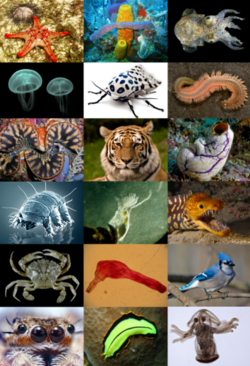Animal
| Animalia | |||
|---|---|---|---|
 | |||
| Scientific classification | |||
| Domain: | Eukaryota | ||
| Clade: | Amorphea | ||
| Clade: | Obazoa | ||
| (unranked): | Opisthokonta | ||
| (unranked): | Holozoa | ||
| (unranked): | Filozoa | ||
| Kingdom: | Animalia Linnaeus,1758 | ||
| Phyla | |||
| |||
| Synonyms | |||
| |||
Animals(orMetazoa) are living creatures withmany cells.Animals get their energy from other living things. Usually, they eat them or areparasites.Animals,plants,fungi,and some other living things have complex cells, so they are grouped together aseukaryotes.
The study of animals is calledzoology.[1][2][3]The study of ancient life is calledpalaeontology.
Most animals aremobile,meaning they can move around. Animals take inoxygen,and give outcarbon dioxide.[4]Thiscellular respirationis part of theirmetabolism(chemical working). In both these ways they are different fromplants.Also, the cells of animals have differentcell membranesto othereukaryoteslike plants andfungi.
Plants are alsomulticellulareukaryoticorganisms,but live by using light, water and basicelementsto make theirtissues.
Grouping animals[change|change source]
There are many different types of animals. The common animals mostpeopleknow are only about 3% of the animal kingdom. Whenbiologistslook at animals, they find things that certain animals have in common. They use this to group the animals in abiological classification.Several million species may exist, but biologists have only identified about one million.
Animals can mainly be divided into two main groups: theinvertebratesand thevertebrates.Vertebrates have abackbone,orspine;invertebrates do not. Vertebrates are the only group to have anadaptive immune system,which may be partly responsible for their size and success.[5][6]
Vertebrates are:
Some invertebrates are:
Life styles[change|change source]
The animal mode ofnutritionis calledheterotrophicbecause they get their food from other living organisms. Some animals eat only plants; they are calledherbivores.Other animals eat onlymeatand are calledcarnivores.Animals that eat both plants and meat are calledomnivores.Some animals get their energy fromphotosyntheticprotiststhat live inside them.
Theenvironmentsanimals live in vary greatly. By the process ofevolution,animalsadaptto thehabitatsthey live in. Afishis adapted to its life in water and aspideris adapted to a life catching and eating insects. Amammalliving on thesavannahsofEast Africalives quite a different life from adolphinorporpoisecatching fish in the sea.
Thefossilrecord of animals goes back about 600 million years to theEdiacaranperiod, or somewhat earlier.[7]During the whole of this long time, animals have been constantlyevolving,so that the animals alive onEarthtoday are very different from those on the edges of the sea-floor in the Ediacaran.
Everyday language[change|change source]
In scientific usage, humans are animals. But in everyday use, humans are often not regarded as animals.
Related pages[change|change source]
- List of animal phyla
- Ethology,the study of animalbehaviour
References[change|change source]
- ↑Alexander, R. McNeill 1990.Animals.Cambridge University Press. Cambridge.ISBN 0-521-34865-X
- ↑Ville C.A; Walker W.F. & Barnes R.D. 1984.General zoology.Saunders
- ↑Hamilton, Gina.Kingdoms of life – Animals.Lorenz Educational Press.ISBN978-1-4291-1610-7
- ↑Cresswell, Julia 2010.The Oxford Dictionary of word origins.2nd ed, New York: Oxford University Press.ISBN 978-0-19-954793-7'having the breath of life', from anima 'air, breath, life'.
- ↑Janeway C.A. 2001. Evolution of the immune system. InImmunobiologyed Janeway et al. 5th ed, 597–607. New York: Garland Science.ISBN978-0-8153-4101-7
- ↑Hirano, Masayuki; Das, Sabyasachi; Guo, Peng; Cooper, Max D. (2011-01-01), Alt, Frederick W. (ed.),Chapter 4 - The evolution of adaptive immunity in vertebrates,Advances in Immunology, vol. 109, Academic Press, pp. 125–157,doi:10.1016/b978-0-12-387664-5.00004-2,ISBN9780123876645,PMID21569914,archivedfrom the original on 2019-12-03,retrieved2019-12-03
- ↑Maloof, Adam C.et al2010 (2010)."Possible animal-body fossils in pre-Marinoan limestones from South Australia".Nature Geoscience.3(9): 653–659.Bibcode:2010NatGe...3..653M.doi:10.1038/ngeo934.Archivedfrom the original on 2011-08-28.Retrieved2016-09-22.
{{cite journal}}:CS1 maint: numeric names: authors list (link)Pdf.These fossils are interpreted as being early sponges. They were found in 665-million-year-old rock.
